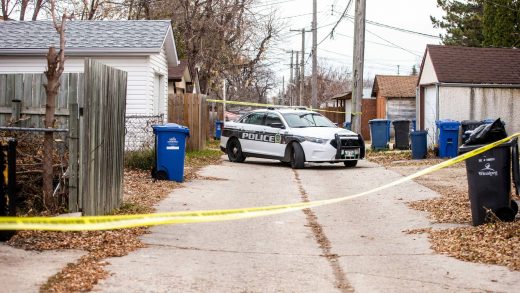More Ecuadorians move to U.S., spared many others’ hurdles

SPRING VALLEY, New York (AP) — Kléver Ortega and Cristina Lema had a good life until COVID-19 crippled Ecuador’s economy.
Ortega was a house-painting contractor and there was work until demand dried up in the pandemic. The entrepreneurial couple launched a pair of food stands. “Then the pandemic hit those, too,” Lema said.
With unemployment, instability and crime rising, they decided to leave for the U.S., following many friends, family and acquaintances.
“We used to hear it in the street: ‘They left. Look who else abandoned their business and took off,’” Lema said. “That’s when we, too, told ourselves, ‘We aren’t earning enough to survive or pay debts.’”
Ecuador — long known for remarkably low rates of crime, despite sitting in South America’s cocaine heartland — is earthquake-prone and has been struggling economically, fighting higher violence and losing its people in record numbers. Like Ortega and Lema, many are headed to the U.S.; the number of Ecuadorians detained near the border with Mexico has spiked.
Biden administration policies introduced in January have sharply reduced illegal U.S. border crossings by targeting migrants from Cuba, Haiti, Nicaragua and Venezuela and getting Mexico to take them back. Migrants from Ecuador and some other countries don’t face the same hurdles, and are generally allowed to stay in the U.S. while they pursue asylum — part of the piecemeal nature of U.S. immigration policy.
___ This is part of an occasional series on how the United States became the world’s top destination for asylum-seekers. ___
The journey can be perilous. In February, a bus crash in Panama killed dozens of migrants, many from Ecuador, as they plunged off a hillside after crossing the notorious Darien Gap from Colombia. And on Monday, a fire at a detention center in the border city Ciudad Juarez killed at least 39 migrants, almost all from Guatemala, Honduras, Venezuela and El Salvador.
The administration wants to be able to send all migrants back to Mexico if they travel through to reach the U.S. border, cross illegally and don’t qualify for exemptions. That proposal, though almost certain to face legal challenges, may be a serious deterrent for Ecuadoreans and other non-Mexicans.
In Ecuador, the economy has been further damaged by strikes against government cutbacks. The economic woes fueled a rise first in minor crimes by those who couldn’t get by. Over time, violent crime, too, escalated — worsened by by the country’s proximity to the cocaine trade.
“Violence got so bad that you couldn’t walk peacefully in the street,” Ortega said at his family’s new apartment in Spring Valley, New York, where they arrived last year.
Ecuadorians dominated the mix of migrants detained by Mexico for the first time in January, according to the Washington Office on Latin America. The reports from Mexico of migrants detained near the border provide some of the best data on the country of origin of those headed to the U.S. — typically a mix of Mexicans, Venezuelans and Central Americans.
On the U.S. side, officials stopped Ecuadoreans 12,000 times at the border in November, about triple the number three months earlier, and nearly 20 times the number from the same period last year, U.S. Customs and Border Protection figures show.
Like many migrants, Ecuadorians typically followed the pattern of single men moving first to establish a foothold. Now, many of the Ecuadorians migrating to the New York area are families. CBP figures show that families with children have grown to about 60% of arrivals, from 15% percent in fiscal year 2020.
The relative ease of current migration is fueling that increase, said Diana Loja, Sleepy Hollow’s liaison to the Latino community.
“It used to take months to get here. Now it takes days,” she told AP as she drove through Sleepy Hollow, pointing out home after home rented by Ecuadorians. Half of the village’s 10,000 people are Latino, with the majority hailing from Ecuador, according to census data.
By some estimates, Sleepy Hollow — about an hour from midtown Manhattan — has the most Ecuadorians per capita in the U.S.
In nearby Spring Valley, Ortega and Lema live in a ground-floor apartment. Last May, they took 26 days to travel from Quito to New York. They remember nearly drowning in a river in Nicaragua, mother and daughter struggling to stay afloat on a raft fashioned of empty plastic bottles. Today, Ortega does repair work in a local pizzeria. Lema makes potatoes, chicken and other food for a restaurant.
In recent years, Loja said, Ecuadorians considering their own migration see a growing number of people to follow in the New York area: “They start to see their neighbors, their friends, their own families.”
Like many migrants, Ecuadorians have stayed closely abreast of migratory rules that allow them to travel to nations on the route to the U.S. Until last year, some 45,000 Ecuadoreans had traveled to Nicaragua, which had no requirements for Ecuadorian travelers. Mexico also was an easy destination for Ecuadorians, until September 2021.
Ortega and Lema said they started their trip by paying a smuggling network $8,500 a person and tried to travel to Nicaragua, but were turned down because they didn’t have the right documents. The network flew them to Panama, where they boarded buses to Costa Rica, Nicaragua, Honduras, Guatemala and Mexico. They crossed the Rio Grande into the U.S. and took a bus to New York.
Ortega and Lema plan to apply for asylum with their 7-year-old daughter, Sofia, in federal court in Manhattan in June.
The factors that drove them to the U.S. continue to drive thousands more Ecuadoreans north, although some are waiting in Mexico for the latest U.S. migration-rule tightening to pass, said Dr. Fredy Rivera, a security analyst at the School of Latin American Social Science in Quito.
“Many people are still in Mexico,” he said of a dip in CBP figures in recent months from the latest record highs “It’s temporary.”
For Ortega, their journey will pay off when their daughter has a better life than what she would have had in Ecuador, where the family sees no sign things will improve anytime soon.
“That was my dream, is my dream,” he said, “For her to get an education here. It’s for that that we came here.”
____
Solano reported from Quito, Ecuador. Elliot Spagat in San Diego contributed to this report.
Credit: More Ecuadorians move to U.S., spared many others’ hurdles


